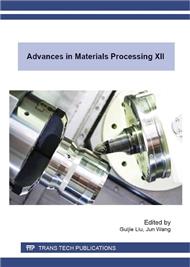[1]
J. Olesen, A. Gustavsson, M. Svensson, et al, The economic cost of brain disorders in Europe, Eur. J. Neurol. 19 (2012) 155-162.
Google Scholar
[2]
E.B. Montgomery, Microelectrode targeting of the subthalamic nucleus for deep brain stimulation surgery, Mov. Disord. 27 (2012) 1387-1391.
DOI: 10.1002/mds.25000
Google Scholar
[3]
N.V. Datla, B. Konh, M. Honarvar, et al, A model to predict deflection of bevel-tipped active needle advancing in soft tissue, Med. Eng. Phys. 36 (2014) 285-293.
DOI: 10.1016/j.medengphy.2013.11.006
Google Scholar
[4]
O. Goksel, E. Dehghan, S.E. Salcudean, Modeling and simulation of flexible needles, Med. Eng. Phys. 31 (2009) 1069-1078.
DOI: 10.1016/j.medengphy.2009.07.007
Google Scholar
[5]
A. Asadian, M.R. Kermani, R.V. Patel, An analytical model for deflection of flexible needles during needle insertion, IEEE. Int. Conf Intell. Rob. Syst. (2011) 2551-56.
DOI: 10.1109/iros.2011.6094959
Google Scholar
[6]
R.J. Webster, J.S. Kim, N.J. Cowan, et al, Nonholonomic modeling of needle steering, Int. J. Rob. Res. 25 (2006) 509-525.
Google Scholar
[7]
N. Abolhassani, R. Patel, F. Ayazi, Effects of different insertion methods on reducing needle deflection, Annu. Int. Conf. IEEE. Eng. Med. Biol. Proc. (2007) 491-494.
DOI: 10.1109/iembs.2007.4352330
Google Scholar
[8]
J.A. Engh, G. Podnar, D. Kondziolka, et al, Toward effective needle steering in brain tissue, Annu. Int. Conf. IEEE. Eng. Med. Biol. Proc. (2006) 559-562.
DOI: 10.1109/iembs.2006.260167
Google Scholar
[9]
J.P. Swensen, M.D. Lin, A.M. Okamura, et al, Torsional dynamics of steerable needles: modeling and fluoroscopic guidance, IEEE. Trans. Biomed. Eng. 61 (2014) 2707-2717.
DOI: 10.1109/tbme.2014.2326161
Google Scholar
[10]
N.R. Abolhassani, R. Patel, M. Moallem, Needle insertion into soft tissue: a survey, Med. Eng. Phys. 29 (2007) 413-431.
DOI: 10.1016/j.medengphy.2006.07.003
Google Scholar
[11]
B. Rashid, M. Destrade, M.D. Gilchrist, Mechanical characterization of brain tissue in compression at dynamic strain rates, J. Mech. Behav. Biomed. Mater. 10 (2012) 23-38.
DOI: 10.1016/j.jmbbm.2012.01.022
Google Scholar
[12]
K.B. Reed, A.M. Okamura, N.J. Cowan, Modeling and control of needles with torsional friction, IEEE. Trans. Biomed. Eng. 56 (2009) 2905-2916.
DOI: 10.1109/tbme.2009.2029240
Google Scholar
[13]
M.Z. Kiss, T. Varghese, T.J. Hall, Viscoelastic characterization of in vitro canine tissue, Phys. Med. Biol. 49 (2004) 4207-4218.
DOI: 10.1088/0031-9155/49/18/002
Google Scholar
[14]
B. Rashid, M. Destrade, M.D. Gilchrist, Mechanical characterization of brain tissue in tension at dynamic strain rates, J. Mech. Behav. Biomed. Mater. 33 (2014) 43-54.
DOI: 10.1016/j.jmbbm.2012.07.015
Google Scholar
[15]
Y.B. Lu, F. Franze, G. Seifert, et al, Viscoelastic properties of individual glial cells and neurons in the CNS, Proc. Natl. Acad. Sci. 103 (2006) 17759-17764.
DOI: 10.1073/pnas.0606150103
Google Scholar


